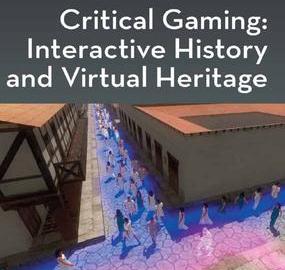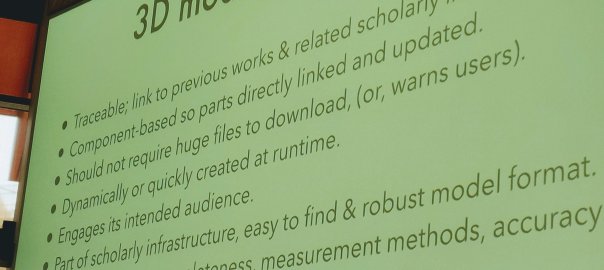| Playing with the Past: Into the Future (Human–Computer Interaction Series), 2nd ed. |
| from Springer-Nature: “Dear Prof. Erik Champion, Your book “Playing with the Past: Into the Future (Human–Computer Interaction Series), 2nd ed.” is currently planned to be published by 30.10.2022.” |
Category Archives: HCI
PhD scholarship available
A Framework for Developing Educational Games in and with Australian Museums
This PhD project focuses on reviewing challenges and successes in Australian museums (MOD, National Maritime Museum and the South Australian Museum) with the aim to develop a participatory open-ended game framework to encourage greater engagement, wider audiences, and increased visitation, as well as reuse of content, data, and related media.
The successful candidate will focus on either the evaluation and framework based on interviews, surveys and workshops with museum experts, or on developing overall game mechanics examples (game prototypes) showcasing best practice game techniques for showcasing Australian museum content, promoting reuse.
This project is funded for reasonable research expenses. Additionally, a living allowance scholarship of $28,854 per annum is available to Australian and New Zealand citizens, and permanent residents of Australia, including permanent humanitarian visa holders. A fee-offset or waiver for the standard term of the program is also included. For full terms and benefits of the scholarship please refer to our scholarship information.
URL here.

“Cultural Heritage Infrastructures in Digital Humanities” free for 7 days
Cultural Heritage Infrastructures in Digital Humanities (2017) is free to access for one week, get free access to the book (via this link) for 7 days.
After this 7-day period, you can buy a copy for £10/$15!
You can also visit the official Routledge History, Heritage Studies etc. Twitter page
and thanks to Routledge editor Heidi Lowther.

free Critical Gaming eBook for 7 days
Critical Gaming: Interactive History and Virtual Heritage (2015 edition) is in a Routledge campaign for May (2020), which allows anyone to register and get free access to the book (via this link) for 7 days. After this 7-day period, they can buy a copy for £10/$15! *Trust me this is a lot cheaper than before!
Also check out the official Routledge History, Heritage Studies etc. Twitter page
Is there a catch? I honestly don’t know but don’t think so!

Digital Heritage: Presenting Futures Past
I gave a keynote Monday 9 December at Dhdownunder 2019, University of Newcastle, Newcastle, Australia. The title was Digital Heritage: Presenting Futures Past
The slides can be viewed and downloaded in the nzerik directory at slideshare.
MAIN POINTS
- Digital heritage, Virtual Heritage, Extended Reality (XR): what are they?
- Can gaming, AR or MR provide insight to the past?
- OR: Are they a waste of money, expensive new technology?
- Could, for example, digital heritage pose a threat to culture?
- Ziauddin Sardar 1995: “Cyberspace is a giant step forward towards museumization of the world: where anything remotely different from Western culture will exist only in digital form.”
- Digital Heritage highlights and challenges (interactive + immersive examples).
To cut over 80 slides short, my answers to the initial questions are
- VR: “reality”: untapped potential, save the IxD!! (We should preserve and disseminate the interaction design and experience, academic papers are not the answer here).
- Gaming, AR, MR provides insight to the past-but learning more from designing.
- High-technology gets in the way.
- Digital Heritage poses a threat to culture, if we don’t clearly consider “culture”.
- Sardar: Cyberspace a symptom not a cause, museumization a partially necessary evil, Western culture is a vague target.
- Digital Heritage communicates, seldom preserves, more end-user involvement required.
I suggest future research and potential solutions are
- Flexible formats, agreed standards, sensory interfaces
- New mechanics, cultural significance and care
- Levels of resolution, access layers
- 3D infrastructure links to data, research, community, XR
- Encourage creative re-use by end-users
Tomorrow’s OZCHi2019 keynote
http://ozchi2019.visemex.org/wp/
Experiential Tourism and Virtual Heritage: the interaction design challenges.
Material heritage decays, intangible heritage disappears. But virtual heritage (virtual reality serving the aims of digital cultural heritage) has performed abysmally when attempting to preserve either, and whether virtual heritage communicates heritage values effectively, is up for debate. Former UNESCO World Heritage expert Alonso Addison, warned (Addison, 2008) there is a “vanishing virtual.” And Hal Thwaites declared digital heritage projects disappear faster than the actual heritage sites, artefacts, and practices that they simulate (Thwaites, 2013). Yet there is a huge market opportunity. Australian tourism is predicted to recoup $143 billion this year (Ludlow & Housego, 2019) and nearly 30% of international visitors visit a museum or gallery (Ludlow, 2019). Can gaming and XR (virtual reality, augmented reality and mixed reality) provide insight to the past and leverage the cultural tourism market? Or are the interaction design challenges underestimated?
- Addison, A. C. (2008). The Vanishing Virtual: Safeguarding Heritage’s Endangered Digital Record. In Y. E. Kalay, T. Kvan, & J. Affleck (Eds.), New Heritage: New Media and Cultural Heritage. (pp. 27-39). Oxfordshire UK: Routledge.
- Ludlow, M. (2019). Cultural attractions used to lure tourists. Financial Review, 2019(16 November 2019).
- Ludlow, M., & Housego, L. (2019). Tourism now employs one in 13 Australians. Financial Review, 2019(16 November 2019).
- Thwaites, H. (2013). Digital Heritage: What Happens When We Digitize Everything? In E. Ch’ng, V. Gaffney, & H. Chapman (Eds.), Visual Heritage in the Digital Age (pp. 327-348). London: Springer.
